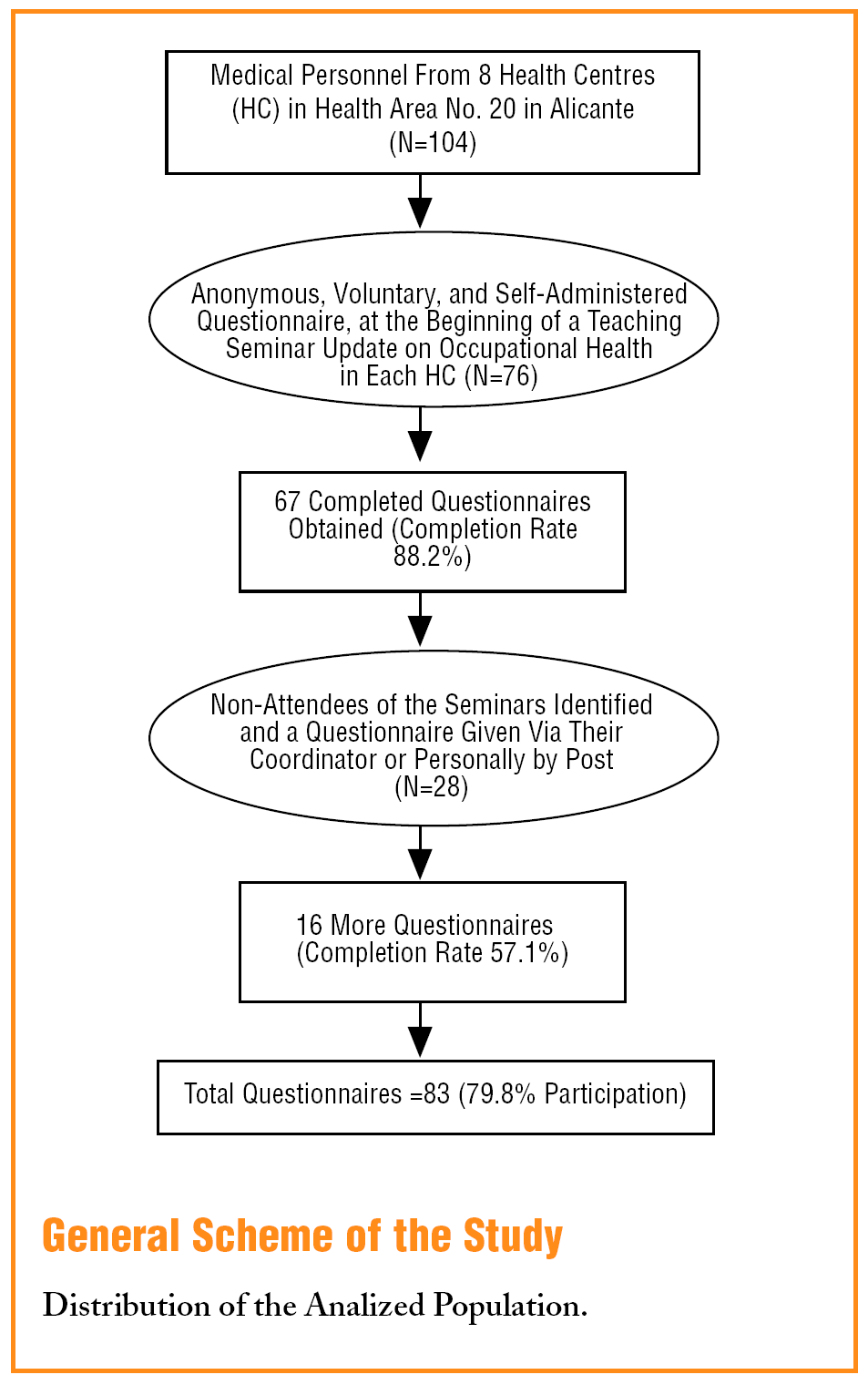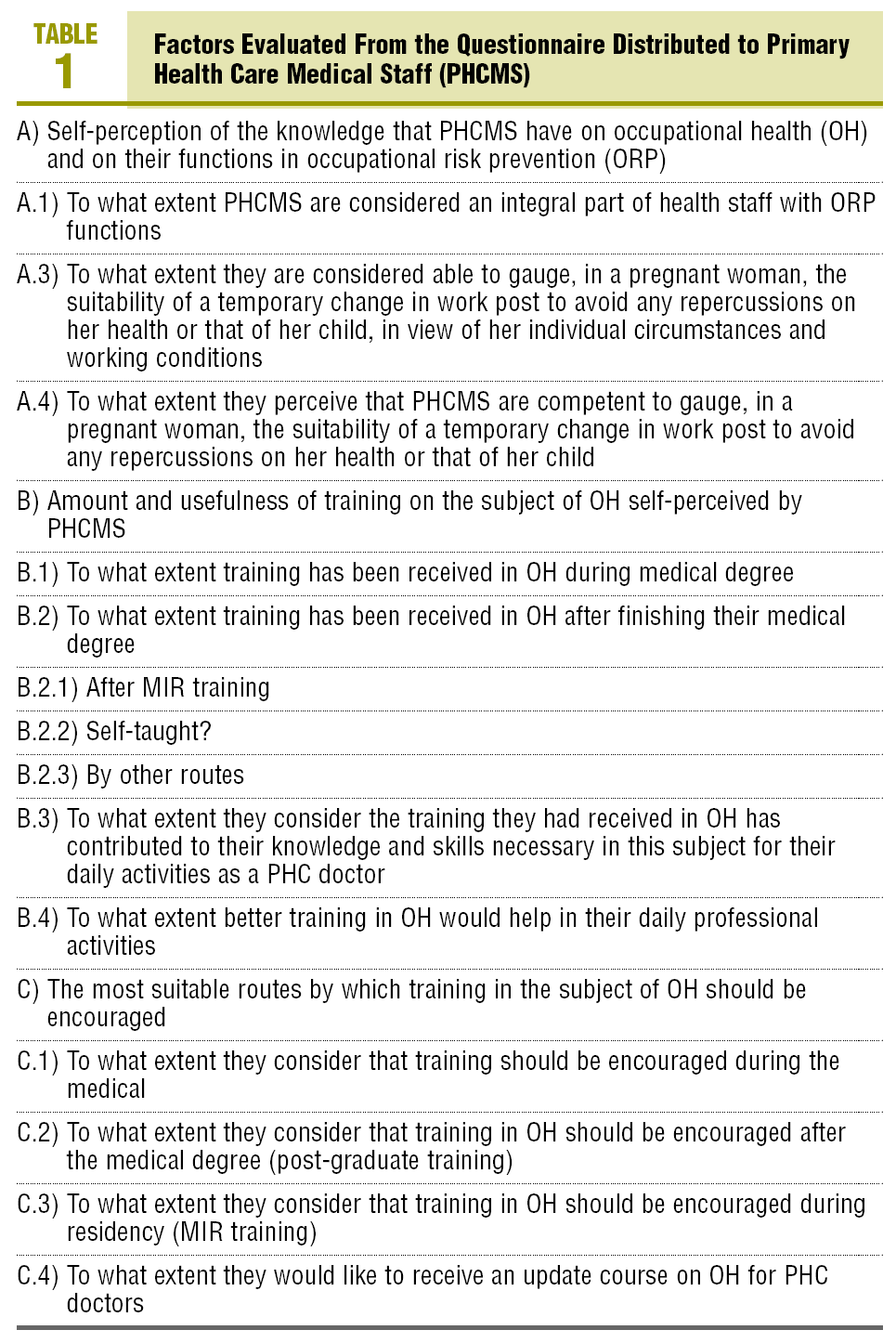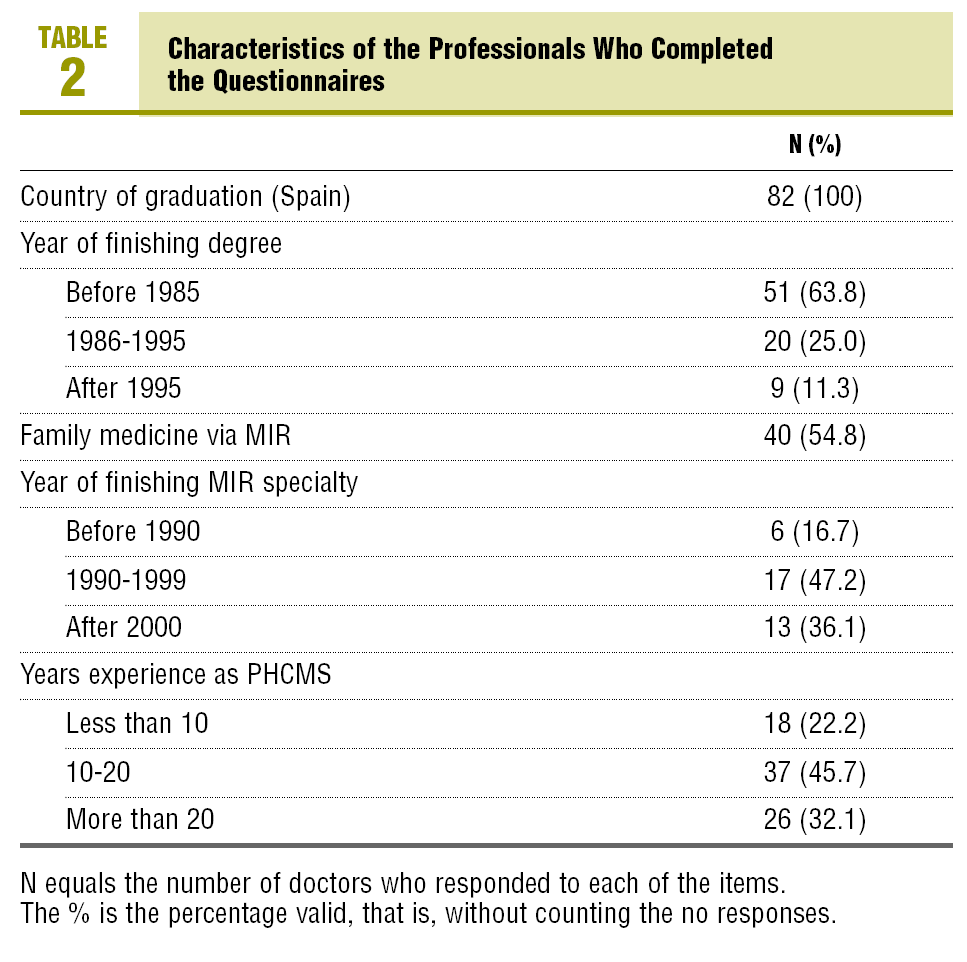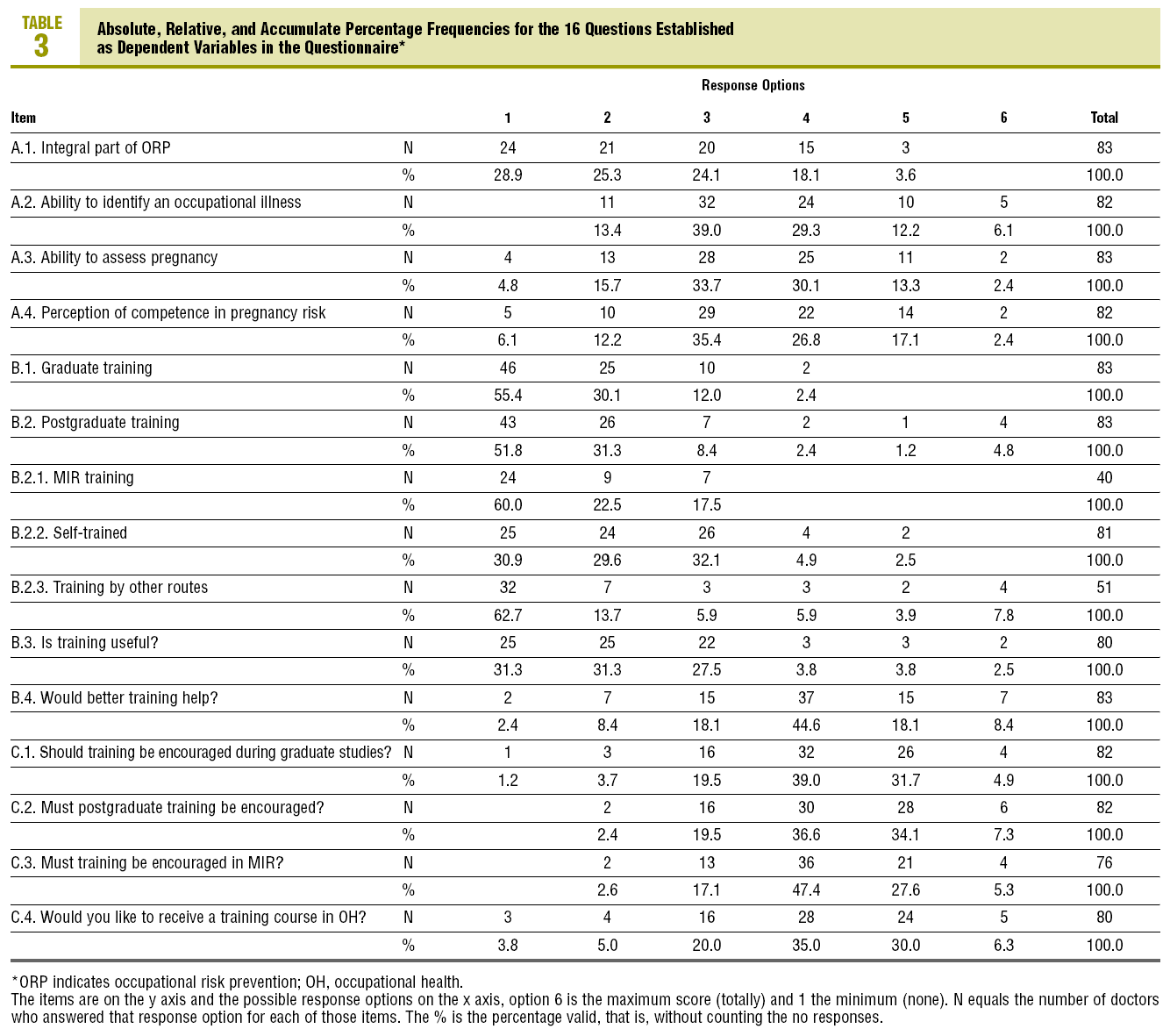Introduction
It has been pointed out that 83% of occupational diseases (diseases where the cause or development results from working conditions) are not recorded in official registers.1 Because of this, many workers with diseases originating from work are cared for by primary health care medical staff (PHCMS) in the Public Health System. It has also been published that 15.9% of medical sickness certificates given by PHCMS will actually be for occupational diseases, which would imply an extra cost of 483 million euros to the Public Health System.2
Also, if the PHCMS is not aware of the occupational aetiology that caused the diseases, these figures will not improve. This is highlighted by the true example of the case of a woman in whom the cardiotoxic effects due to occupational exposure to organic solvents were confused with angina.3 This becomes even more significant if we also take into account that certain groups, such a domiciliary workers or those from the black economy and also the unemployed or apprentices, escape the official system of occupational risk prevention (ORP).
PHCMS, thus, have important functions in ORP: they have a fundamental role to help uncover occupational diseases, and even more important still, after the recent publication of a new Royal Decree regarding occupational diseases, where it is established in Article 5 that PHCMS, if they suspect a disease is of occupational origin, must notify an intermediate organisation, still not determined, to the Social Security Management and the contributor units or corresponding MATEPSS (Social Security Accidents at Work and Occupational Diseases Benefit Societies).4 They also have a role as family doctor to become involved in the occupational aetiology of the their patients´ illnesses, in order to establish the appropriate treatment. Then there is the Occupational Risk Prevention Law in its Article 26, together with article 114 of the General Social Security Law, which gives them a role as regards maternity protection against occupational risks, where they have to make a report in which it mentions the pregnancy state (gestation week and its clinical course) and whether the work role carried out can negatively influence the health of the pregnant worker or the foetus, so that the worker may be able to request risk benefit during pregnancy.5,6
To be able to complete these functions, PHCMS need to acquire the knowledge or skills necessary on the subject of OH, and for the acquisition of this knowledge or skills, previous training, either as a medical student, during MIR training, or even postgraduate training, is required.
The objectives of the present study was: to evaluate the self-perceived level of knowledge that PHCMS have on OH and their functions in ORP; to assess the amount and usefulness of training on the subject of OH received by PHCMS; to identify the most appropriate routes which would encourage training in this subject for PHCMS.
Methods
The study was carried out with all the doctors (specialists in family and community medicine, as well as general practitioners) who staff 8 health centres (HC) in a health area in the province of Alicante, Spain.
An anonymous and voluntary questionnaire was distributed between April-June 2006, and was self-completed at the beginning of a teaching seminar on updates in OH at each centre.
At the same time, the doctors who did not attend these seminars were sent one by their medical coordinator or personally, by post. Out of a total of 104 doctors, 83 completed the questionnaire (79.8% of participants), 61 from the seminar days and 16 afterwards. The questionnaire was prepared following basic guidelines described in publications,7,8 and based on other questionnaires with similar objectives and successfully applied.9,10 Its contents were positively evaluated by experts (Francisco Bolumar and Gonzalo Tamayo). Finally, a pilot run was made in order to test its viability.
On the first page of the questionnaire, it explained that the objective was to find out the perception doctors had on the subject of OH, encouraging them to read it and fill it in honestly and carefully, giving them all the time necessary.
Four questions (independent variables) referred to the country in which they graduated, the year they finished their course, if they were specialists in family and community medicine by the MIR route and the year they finished it, as well as years of experience.
Another 15 questions were established as dependent variables with a possible response by choosing a value between 1 and 6. It was pointed out that 6 represented the maximum score and 1, the minimum.
The factors evaluated using these questions are shown in Table 1.
The different percentages of response options and quartiles of each item were calculated, and these variables were contrasted with the variables considered as independent: year of graduation, time worked or whether the PHCMS had MIR training, using χ2 and the Mann-Whitney U test. Data analysis was performed using the Microsoft SPSS/PC v 12.0 package and Excel calculation sheet.
Results
The sample characteristics of the considered independent variable are shown in Table 2. As regards the rest of the items, PHCMS did not considered themselves as members of a health staff group with functions in occupational risk prevention (median [Me], 2; interquartile range [IR], 1-3); 78.3% of the sample gave low scores (response option, 3 or less) for this item (Table 3). There was no statistically significant change in this perception as regards the year of graduation, time worked or whether the PHCMS were MIR trained or not.
To a large extent PHCMS considered themselves capable of identifying whether an illness seen in their clinic was of work origin or not (Me, 3; IR, 3-4) (Table 2). Doctors with more work experience saw themselves as more capable in this matter, although these differences were not statistically significant (P=.06).
Although with a wider variation in opinions, PHCMS perceived that it was within their responsibilities to judge whether a pregnant women should have a temporary change of post to avoid any repercussions on her health or that of her child (Me, 3; IR, 3-4); likewise, they considered themselves fairly competent to do this (Table 3).
Training in OH during medical school was identified as being of minor importance along with the MIR route, and the results are very homogeneous. No doctor who graduated after 1995 (the year the ORP Law was published) scored more than 3 as regards OH training during medical school.
A limited number of professionals had been trained in OH subjects by other routes, among which was studying occupational medicine as a specialty (N=4), work in MATEPSS (N=1) or through continuous education or university postgraduate training. Lastly, self-taught training was mentioned by a large number of doctors, although at a lower level (Table 3).
PHCMS clearly thought that more training in OH would help them in their professional daily activities, with high scores (4 or more) by 70% of those interviewed. They also believed that this training should be promoted by all routes, although postgraduate training scored slightly more than the rest (Table 3). The provision of a course within continuous or continued education was seen as a good idea in this case (Table 3).
Discussion
Approaching doctors in seminars without previous warning can be seen as a selection bias, as those who did not go the seminar could have different opinions from their colleagues. This group was identified in the present study, and the questionnaire was also distributed to them. On the other hand, the seminars are not seen as obligatory, therefore the reasons for not attending could probably be attributed to work situations, such as sick leave or holidays or due to home visits, instead of factors that could cause a bias, such as, for example, better trained in occupational health. Finally, there were no significant differences when comparing the results of the completed questionnaires obtained in the seminars with those obtained later. This fact, along with the high general response obtained (79.8%), makes selection bias unlikely. On the other hand, at no time during the distribution of the questionnaire was there mention or evidence of interest for quantifying and publishing the results, which meant that, along with the anonymity of the questionnaire, masking conditions were guaranteed.
The questionnaire design followed basic rules associated with the preparation of questionnaires and its structure was similar to other questionnaires successfully applied in similar contexts. As regards the content validity, this had been positively assessed by experts.
Offering an even number of alternatives avoided the tendency for centralised responses. Thus, an effort was made to analyse the perceptions of PHCMS on the subject of OH by the most thorough methods. Our results show that, at least in the population taking part in this study, PHCMS did not perceive that they had functions as regards ORP. Neither did they perceive that they had a high level of skill to carry out their primary functions in this subject, such whether they could identify the occupational origin of an illness or a maternity protection problem seen in their clinics.
To improve the identification and recording of occupational diseases was recognise as a priority in OH in a recent study in which a total of 181 professionals with experience in the ORP field took part.11 To achieve this priority, the establishing of OH information systems was considered as a necessity, where PHCMS and other Public Health System specialists can be notified of diseases of occupational origin seen in their clinics, as those systems, correctly designed, have shown to be effective. Orriols et al12 demonstrated that in Catalonia, using an occupational epidemiology surveillance system where, every 2 months during the year 2002, a group of medical volunteers, which included PHCMS, filled in a card with different pneumonology diagnoses, 21 mesotheliomas and 1 bronchopulmonary cancer associated with asbestos were recorded. However, in the official statistics for the whole of Spain, only 14 cases of cancer due to asbestos were recorded in the same year.13
On the other hand, in Castilla-La Mancha clusters of polyneuropathy due to N-hexane were identified in 1998 using these surveillance systems. The appropriate notification of these cases by primary and specialised care helped to indicate the suspicion of "occupational poisoning" as regards the polyneuropathy cases in a short space of time. This also led to the setting up of research and coordination activities between health and employer administrations, which enabled suitable prevention and monitoring measures to be applied to prevent more cases appearing.14
For these systems to function correctly, the doctors in the Public Health System need to be suitably skilled in identifying whether or not an illness is of occupational origin. Our results demonstrate the perception by doctors of a lack of training in this subject. Elms et al15 in the United Kingdom have shown that same need. There have also been complaints on lack of training in our country.16,17
Although the Law on Occupational Risk Prevention was published in 1995, it seems that there are no new university study or MIR training plans being made on the subject of OH. This lack of pre-graduation training has been demonstrated in other European Union countries, such as Germany8, or the United Kingdom, where only 6 of the 19 medical schools investigated in the year 2000 gave at least 6 hours of training in OH,19 and in other developed countries, such as the USA.20 Universities in other countries, such as the United Arab Emirates, on the other hand, include more OH training in their study plans, with 15 hours of theory and 3 hours of company visits. This training has also been perceived as very useful by their students.21
Isolated initiatives in postgraduate training, such as the distance learning course developed in collaboration with the Ministries of Works and Health,22 has shown to be insufficient compared to the training given in other countries, with longer courses and visits to work places.23 Better training in OH, therefore, is needed in Spain, both in medical schools and at postgraduate level, so that PHCMS can feel to be a health personnel member with functions in ORP and BE able to acquire the necessary knowledge and skills on this subject for their routine clinical practice.
Acknowledgements
The authors are thankful for the computer support provided by Javier Martínez Lorente in the preparation of this article.
What Is Known About the Subject
• Complaints have been made to management on the lack of training in occupational health suffered by the primary care doctor, but there are no studies that quantitatively or qualitatively evaluate this training.
• Neither are there any studies that evaluate the perception of the doctors themselves on their lack of training or on other aspects associated with occupational health and primary care.
What This Study Contributes
• Quantitative data is provided from the subjective perception of the primary care doctors themselves. They perceive that there is a quantitative and qualitative lack of training in their curriculum. They do not perceive that they are highly skilled to carry out functions in this subject, such as identifying whether the illnesses seen in their clinics are of occupational origin, or that of maternity protection. However, they do consider that more training in occupational health would help them in their daily professional activities.
Spanish version available
www.doyma.es/191.553
A commentary follow this article
(page. 12)
This study has been partially financed with a grant received from the Fundación Bienvenida Navarro-Luciano
Trípodi (Awards and Grants for Research Projects, Year 2005-2006).
Correspondence: Dr. M. Santibáñez Margüello.
Unidad de SL. Centro de Salud Pública de Elche.
Antonio Mora Ferrández, 51.
03202 Elche. Alicante. España.
E-mail: santibanyez_mig@gva.es
Manuscript received January 31, 2007.
Accepted for publication April 2, 2007.















